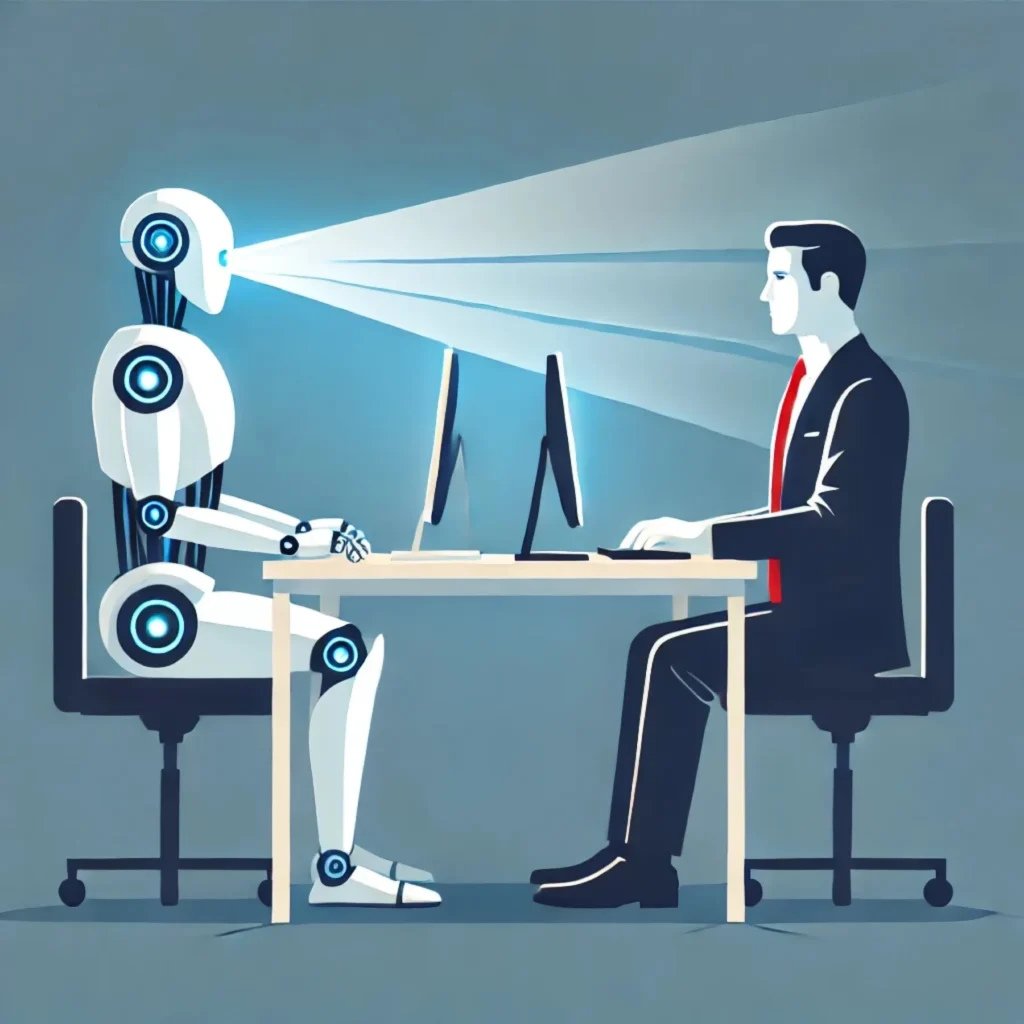In the ever evolving world of HR, one truth that remains constant is employee turnover. But what if we could turn this inevitability into an opportunity for growth and improvement by understanding it better. Knowing why employees leave is as crucial as knowing why they stay. Exit interviews have long been a cornerstone of HR strategy, but the traditional approach often falls short. Manual analysis is time consuming, and biases can cloud the insights. Perfect opportunity to use AI as a transformative solution to revolutionize how organizations gather and act on employee feedback.
AI powered exit interviews can be a game changing tool that promises to revolutionize how we gather and analyze feedback from departing employees.

The Traditional Exit Interview
Exit interviews are a goldmine of information, offering insights into employee satisfaction, workplace culture, and areas for improvement. However, the traditional method of conducting and analyzing these interviews is fraught with challenges. HR teams keep asking the same question, from a standard template, again and again, hoping to uncover why employees are leaving. But often, they are left with surface level insights, potential biases, and a mountain of data to dig through. At the same time, employees sugarcoat feedback, managers dismiss ‘disgruntled’ insights, and HR ends up with data as useful as a screen door on a submarine. I have seen HR teams spending weeks analyzing exit interviews, only to discover the #1 reason for employees leaving to be ‘better opportunities’. It’s like trying to find a needle in a haystack, but with more paperwork. Manual data collection and analysis can be slow and error prone, and employees may not always feel comfortable sharing their true thoughts with a human interviewer. This is where AI steps in, offering a more efficient and unbiased alternative.
The Power of AI in Exit Interviews
Welcome to the era of AI-powered exit interviews, where ‘why did you leave’ becomes ‘how can we make you stay’, or at least ‘learn from your departure’. Every departing employee leaves behind clues like frustrations, suggestions, accolades. However, these clues are scattered across various interviews, spoken in different tones and styles. AI acts as your forensic expert, piecing together these clues to reveal a coherent narrative. By analyzing sentiment, identifying recurring themes, and even picking up on subtle linguistic cues, AI-powered systems can detect issues that might otherwise fly under the radar.
These tools use advanced algorithms to analyze vast amounts of data quickly, identifying patterns and trends that might escape the human eye. For example, what happens when multiple exit interviews hint at a lack of career growth, but each employee uses different words to describe the issue? While one might mention stagnation, another could say lack of upward trajectory, and yet another might allude to a ceiling that just wont budge, the human eye might miss these nuances. AI, however, recognises these as interconnected signals pointing to a deeper, systemic problem. With the power of natural language processing and machine learning, AI transforms this complex, unstructured data into clear, actionable insights. It is like having a super smart translator that converts emotional feedback into a strategic roadmap for organizational improvement. A system that not only captures feedback but also understands the sentiment behind it. It’s like having a mind-reader, but for employee feedback.
Prime benefits of using AI powered Exit Interviews Analysis:
Unbiased Insights
One of the biggest advantages of AI is its ability to provide unbiased analysis. AI provides a neutral platform for employees to share their experiences. By eliminating human bias, AI encourages more honest and open feedback. Employees might feel more comfortable sharing their true feelings with an AI assistant, knowing their responses are confidential and won’t be directly scrutinized by a human. It’s like having a confidant who never judges.
Real-Time Analysis
AI can process and analyze feedback in real-time, quickly identifying common themes and sentiments. This allows organizations to address issues promptly and proactively.
Predictive Analytics
Predictive analytics can even forecast future turnover trends, enabling HR to take preemptive measures. By analyzing past exit interviews, it can identify departments or teams at risk of higher attrition rates. This allows HR to be proactive, not reactive, in addressing potential issues before they escalate. For example, if multiple employees mention ‘work-life balance’ as a reason for leaving, AI can flag this as a potential issue for the organization to address. This means organizations can uncover hidden patterns and insights that might be missed in traditional analyses.
Enhanced Data Collection and Analysis
AI-driven tools can adapt interview questions based on responses, delving deeper into specific issues. Natural language processing (NLP) enables AI to understand the context and nuances of employee feedback, providing more accurate sentiment analysis.
Compatibility and Scalability
Modern AI-powered exit interview platforms are designed with compatibility in mind. They offer robust APIs and data exchange protocols, making it simple for HR tech stacks to integrate seamlessly. This means that insights generated from exit interviews can be fed directly into talent management systems, learning platforms, or even leadership dashboards. When all such initiatives of HR ‘talk’ to each other, it leads to a dynamic and positive responsive HR environment where data flows effortlessly and decisions are informed by real-time, actionable intelligence.
Implementing AI: A Step-by-Step Guide
Standardize and Automate
Ensure your exit interview questions are standardized and consistent. AI can then analyze the data more effectively, identifying trends across responses. Automate the process with AI-driven chatbots to conduct preliminary interviews and capture initial feedback.
Also, Consistency is the key. Ensure your exit interview questions are standardized across the board. This allows AI to easily identify patterns and trends.
Maintain Privacy and Ethical Use
Handling sensitive employee data requires strict privacy protocols. Ensure your AI system anonymizes data and complies with ethical standards to protect employee confidentiality. Let employees know their feedback is confidential. This encourages honesty and provides more accurate data for analysis.
Train Your AI
Tailor your AI system to understand your organization’s specific language and needs. Continuous training and updates keep the system relevant and effective. This ensures it can accurately analyze and interpret feedback.
Balance Tech with Empathy
While AI is a powerful tool, it’s essential to remember the human element. While numbers and sentiment scores are impressive, what truly sets AI-powered exit interview analysis apart is its ability to humanize data. HR is, at its heart, about people. By combining the cold precision of analytics with the warmth of empathetic understanding, organizations can create environments where feedback is not just collected, but truly valued. HR professionals should use AI insights to inform their decisions, not replace their judgment. After all, technology is a tool, not a replacement for human empathy and understanding.
The Future is Here
The future of HR lies at the intersection of technology and humanity. AI-powered exit interviews are not just a futuristic concept; they’re a practical solution for today’s HR challenges. By automating the process, providing unbiased insights, and enabling predictive analytics, AI empowers organizations to make data-driven decisions that improve employee retention and overall satisfaction. As organizations adapt to the evolving demands of the modern workplace, the insights gleaned from these analyses will become increasingly critical. They will guide leadership on everything from culture change to talent strategy, ensuring that companies remain agile, resilient, and ready for tomorrow.
So, why wait? Embrace the power of AI and turn your exit interviews into a goldmine of actionable insights. After all, in the world of HR, knowledge is power, and AI is your new best friend.
#AI #ArtificialIntelligence #HR #HumanResources #HRTech #FutureOfWork #ExitInterviews #EmployeeRetention #EmployeeTurnover #EmployeeFeedback #TalentManagement #WorkforceAnalytics #DataAnalytics #MachineLearning #DataDrivenHR #SentimentAnalysis #HRInnovation #PeopleAnalytics #DigitalHR



